Project: Learning Contract for Hope for Children Crowdfunding Event
VerifiedAdded on 2021/04/24
|40
|7075
|28
Project
AI Summary
This project report presents a student's learning contract for a crowdfunding event, titled "Hope for Children," aimed at raising £10,000 for Jigsaw Autism School to purchase learning equipment. The project utilizes work-based learning and crowdfunding methods to develop skills in communication, teamwork, planning, data analysis, and feedback. The report outlines the project's aims, justification, methods, timetable, and evidence of accomplishment, including a Gantt chart, timetable, campaign planner, and Clifton's Strength Finder test results. It also includes a detailed project background on crowdfunding, references, and appendices. The project spans 10 weeks, with simulations, weekly learning logs, and critical incident diaries used to document the learning process and evaluate the project's success in meeting its objectives.
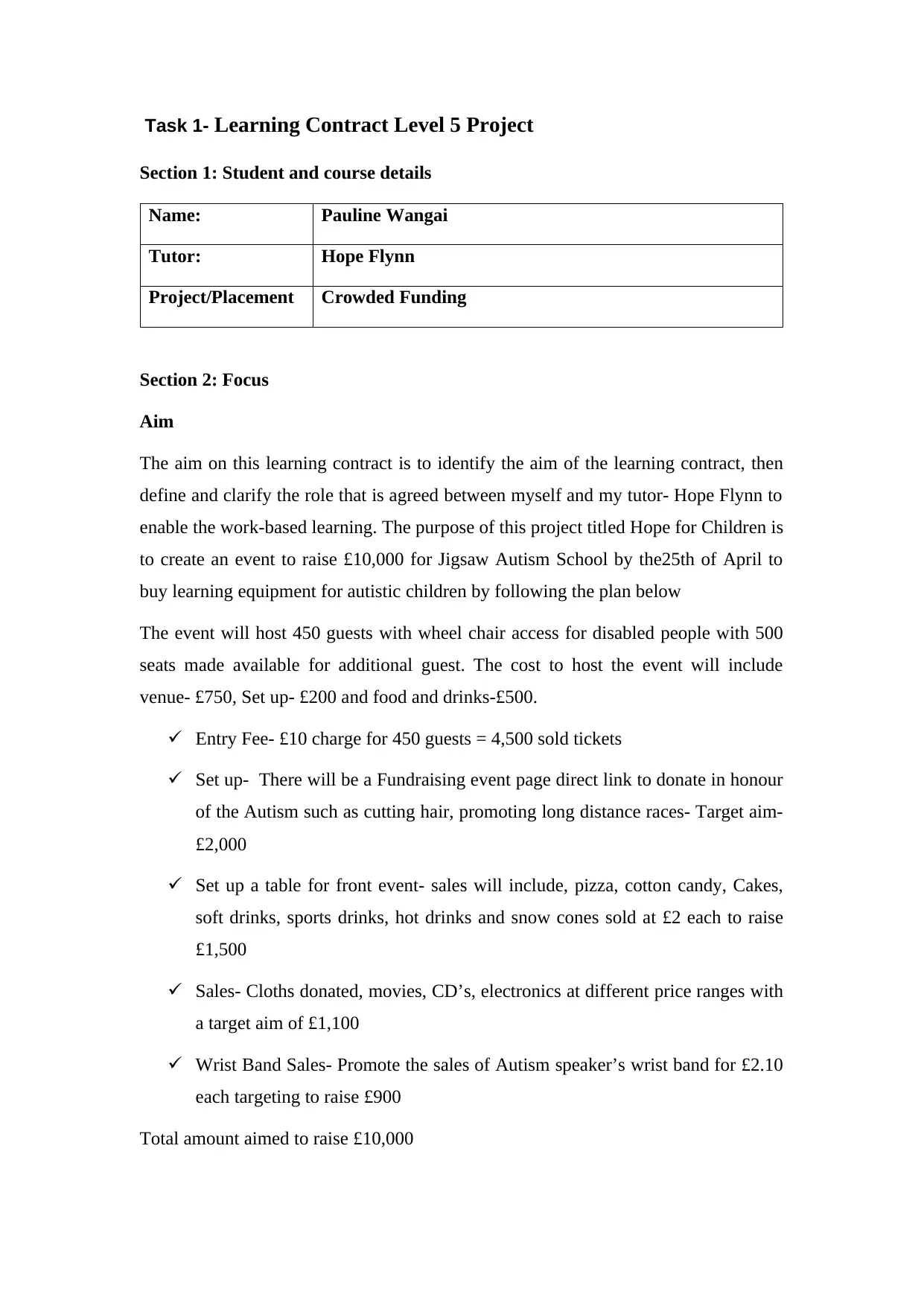
Task 1- Learning Contract Level 5 Project
Section 1: Student and course details
Name: Pauline Wangai
Tutor: Hope Flynn
Project/Placement Crowded Funding
Section 2: Focus
Aim
The aim on this learning contract is to identify the aim of the learning contract, then
define and clarify the role that is agreed between myself and my tutor- Hope Flynn to
enable the work-based learning. The purpose of this project titled Hope for Children is
to create an event to raise £10,000 for Jigsaw Autism School by the25th of April to
buy learning equipment for autistic children by following the plan below
The event will host 450 guests with wheel chair access for disabled people with 500
seats made available for additional guest. The cost to host the event will include
venue- £750, Set up- £200 and food and drinks-£500.
Entry Fee- £10 charge for 450 guests = 4,500 sold tickets
Set up- There will be a Fundraising event page direct link to donate in honour
of the Autism such as cutting hair, promoting long distance races- Target aim-
£2,000
Set up a table for front event- sales will include, pizza, cotton candy, Cakes,
soft drinks, sports drinks, hot drinks and snow cones sold at £2 each to raise
£1,500
Sales- Cloths donated, movies, CD’s, electronics at different price ranges with
a target aim of £1,100
Wrist Band Sales- Promote the sales of Autism speaker’s wrist band for £2.10
each targeting to raise £900
Total amount aimed to raise £10,000
Section 1: Student and course details
Name: Pauline Wangai
Tutor: Hope Flynn
Project/Placement Crowded Funding
Section 2: Focus
Aim
The aim on this learning contract is to identify the aim of the learning contract, then
define and clarify the role that is agreed between myself and my tutor- Hope Flynn to
enable the work-based learning. The purpose of this project titled Hope for Children is
to create an event to raise £10,000 for Jigsaw Autism School by the25th of April to
buy learning equipment for autistic children by following the plan below
The event will host 450 guests with wheel chair access for disabled people with 500
seats made available for additional guest. The cost to host the event will include
venue- £750, Set up- £200 and food and drinks-£500.
Entry Fee- £10 charge for 450 guests = 4,500 sold tickets
Set up- There will be a Fundraising event page direct link to donate in honour
of the Autism such as cutting hair, promoting long distance races- Target aim-
£2,000
Set up a table for front event- sales will include, pizza, cotton candy, Cakes,
soft drinks, sports drinks, hot drinks and snow cones sold at £2 each to raise
£1,500
Sales- Cloths donated, movies, CD’s, electronics at different price ranges with
a target aim of £1,100
Wrist Band Sales- Promote the sales of Autism speaker’s wrist band for £2.10
each targeting to raise £900
Total amount aimed to raise £10,000
Paraphrase This Document
Need a fresh take? Get an instant paraphrase of this document with our AI Paraphraser
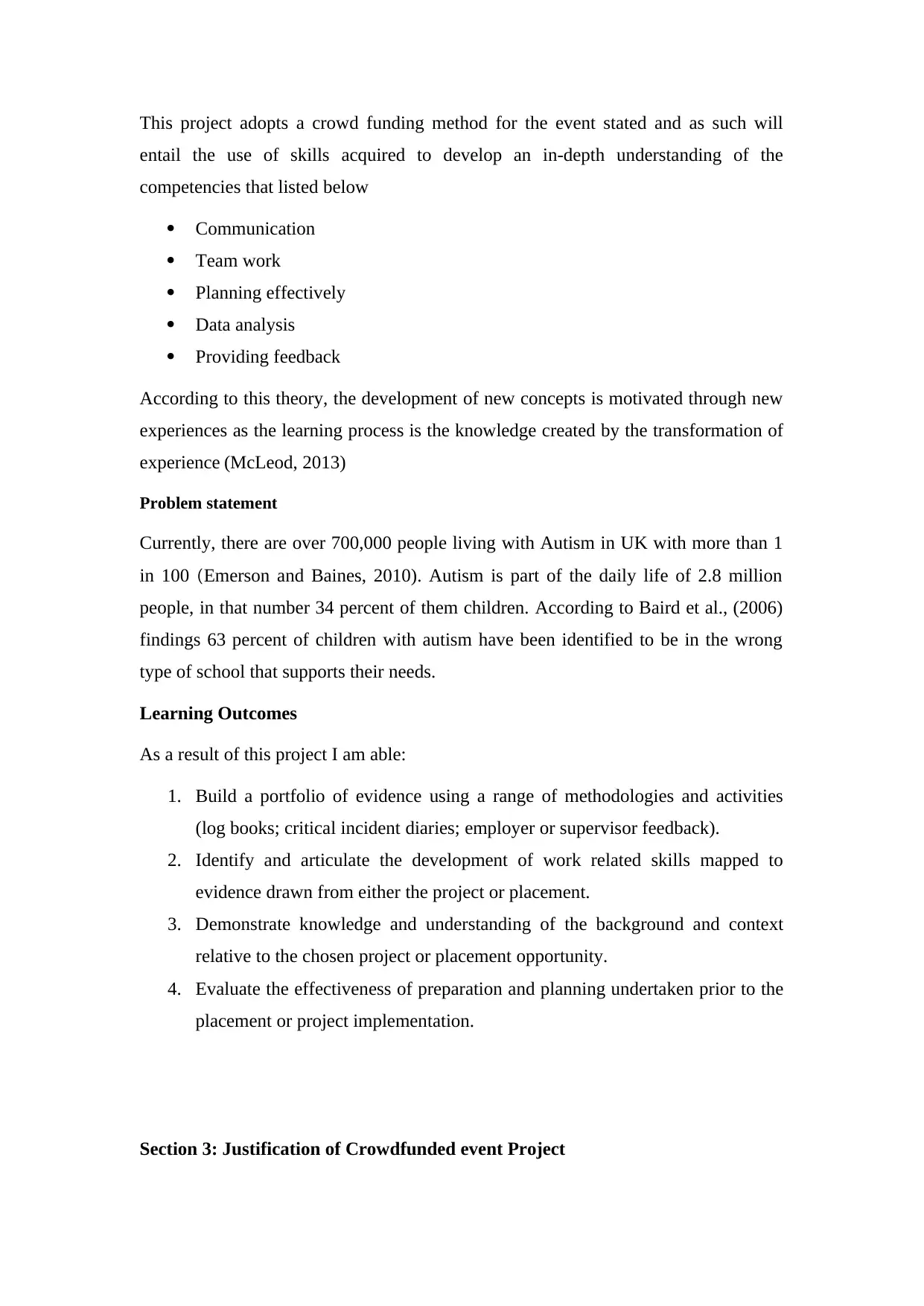
This project adopts a crowd funding method for the event stated and as such will
entail the use of skills acquired to develop an in-depth understanding of the
competencies that listed below
Communication
Team work
Planning effectively
Data analysis
Providing feedback
According to this theory, the development of new concepts is motivated through new
experiences as the learning process is the knowledge created by the transformation of
experience (McLeod, 2013)
Problem statement
Currently, there are over 700,000 people living with Autism in UK with more than 1
in 100 (Emerson and Baines, 2010). Autism is part of the daily life of 2.8 million
people, in that number 34 percent of them children. According to Baird et al., (2006)
findings 63 percent of children with autism have been identified to be in the wrong
type of school that supports their needs.
Learning Outcomes
As a result of this project I am able:
1. Build a portfolio of evidence using a range of methodologies and activities
(log books; critical incident diaries; employer or supervisor feedback).
2. Identify and articulate the development of work related skills mapped to
evidence drawn from either the project or placement.
3. Demonstrate knowledge and understanding of the background and context
relative to the chosen project or placement opportunity.
4. Evaluate the effectiveness of preparation and planning undertaken prior to the
placement or project implementation.
Section 3: Justification of Crowdfunded event Project
entail the use of skills acquired to develop an in-depth understanding of the
competencies that listed below
Communication
Team work
Planning effectively
Data analysis
Providing feedback
According to this theory, the development of new concepts is motivated through new
experiences as the learning process is the knowledge created by the transformation of
experience (McLeod, 2013)
Problem statement
Currently, there are over 700,000 people living with Autism in UK with more than 1
in 100 (Emerson and Baines, 2010). Autism is part of the daily life of 2.8 million
people, in that number 34 percent of them children. According to Baird et al., (2006)
findings 63 percent of children with autism have been identified to be in the wrong
type of school that supports their needs.
Learning Outcomes
As a result of this project I am able:
1. Build a portfolio of evidence using a range of methodologies and activities
(log books; critical incident diaries; employer or supervisor feedback).
2. Identify and articulate the development of work related skills mapped to
evidence drawn from either the project or placement.
3. Demonstrate knowledge and understanding of the background and context
relative to the chosen project or placement opportunity.
4. Evaluate the effectiveness of preparation and planning undertaken prior to the
placement or project implementation.
Section 3: Justification of Crowdfunded event Project
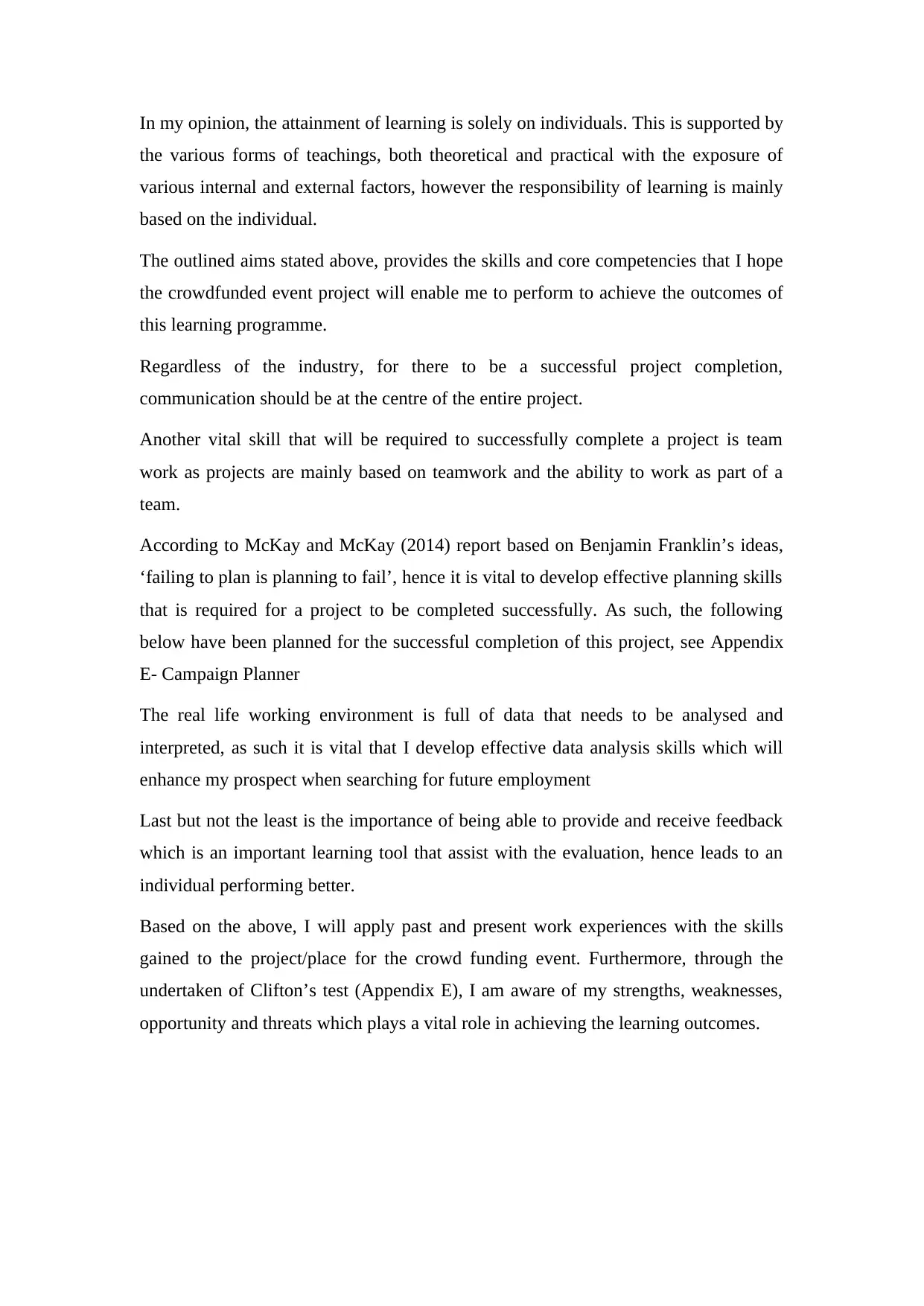
In my opinion, the attainment of learning is solely on individuals. This is supported by
the various forms of teachings, both theoretical and practical with the exposure of
various internal and external factors, however the responsibility of learning is mainly
based on the individual.
The outlined aims stated above, provides the skills and core competencies that I hope
the crowdfunded event project will enable me to perform to achieve the outcomes of
this learning programme.
Regardless of the industry, for there to be a successful project completion,
communication should be at the centre of the entire project.
Another vital skill that will be required to successfully complete a project is team
work as projects are mainly based on teamwork and the ability to work as part of a
team.
According to McKay and McKay (2014) report based on Benjamin Franklin’s ideas,
‘failing to plan is planning to fail’, hence it is vital to develop effective planning skills
that is required for a project to be completed successfully. As such, the following
below have been planned for the successful completion of this project, see Appendix
E- Campaign Planner
The real life working environment is full of data that needs to be analysed and
interpreted, as such it is vital that I develop effective data analysis skills which will
enhance my prospect when searching for future employment
Last but not the least is the importance of being able to provide and receive feedback
which is an important learning tool that assist with the evaluation, hence leads to an
individual performing better.
Based on the above, I will apply past and present work experiences with the skills
gained to the project/place for the crowd funding event. Furthermore, through the
undertaken of Clifton’s test (Appendix E), I am aware of my strengths, weaknesses,
opportunity and threats which plays a vital role in achieving the learning outcomes.
the various forms of teachings, both theoretical and practical with the exposure of
various internal and external factors, however the responsibility of learning is mainly
based on the individual.
The outlined aims stated above, provides the skills and core competencies that I hope
the crowdfunded event project will enable me to perform to achieve the outcomes of
this learning programme.
Regardless of the industry, for there to be a successful project completion,
communication should be at the centre of the entire project.
Another vital skill that will be required to successfully complete a project is team
work as projects are mainly based on teamwork and the ability to work as part of a
team.
According to McKay and McKay (2014) report based on Benjamin Franklin’s ideas,
‘failing to plan is planning to fail’, hence it is vital to develop effective planning skills
that is required for a project to be completed successfully. As such, the following
below have been planned for the successful completion of this project, see Appendix
E- Campaign Planner
The real life working environment is full of data that needs to be analysed and
interpreted, as such it is vital that I develop effective data analysis skills which will
enhance my prospect when searching for future employment
Last but not the least is the importance of being able to provide and receive feedback
which is an important learning tool that assist with the evaluation, hence leads to an
individual performing better.
Based on the above, I will apply past and present work experiences with the skills
gained to the project/place for the crowd funding event. Furthermore, through the
undertaken of Clifton’s test (Appendix E), I am aware of my strengths, weaknesses,
opportunity and threats which plays a vital role in achieving the learning outcomes.
⊘ This is a preview!⊘
Do you want full access?
Subscribe today to unlock all pages.

Trusted by 1+ million students worldwide
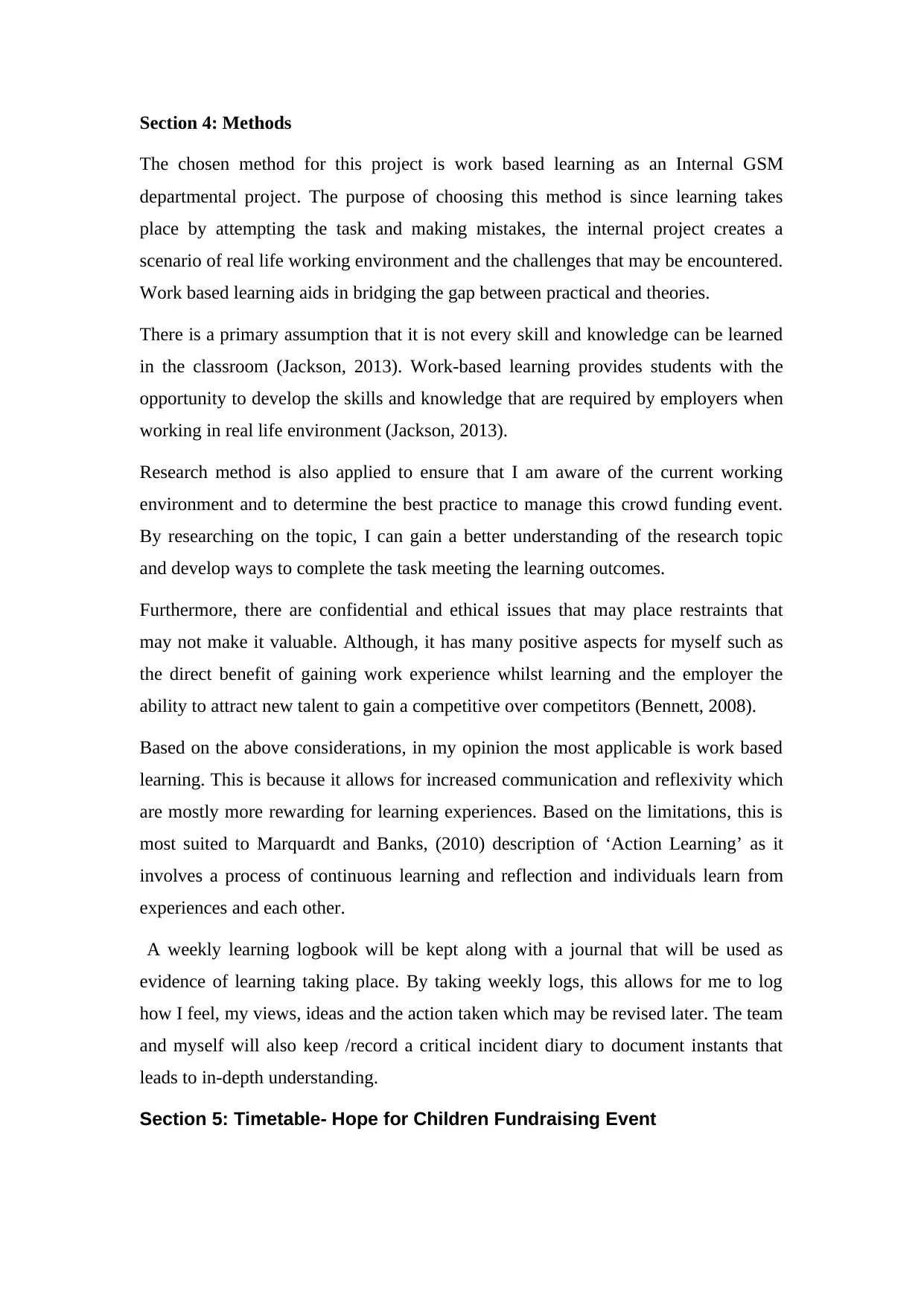
Section 4: Methods
The chosen method for this project is work based learning as an Internal GSM
departmental project. The purpose of choosing this method is since learning takes
place by attempting the task and making mistakes, the internal project creates a
scenario of real life working environment and the challenges that may be encountered.
Work based learning aids in bridging the gap between practical and theories.
There is a primary assumption that it is not every skill and knowledge can be learned
in the classroom (Jackson, 2013). Work-based learning provides students with the
opportunity to develop the skills and knowledge that are required by employers when
working in real life environment (Jackson, 2013).
Research method is also applied to ensure that I am aware of the current working
environment and to determine the best practice to manage this crowd funding event.
By researching on the topic, I can gain a better understanding of the research topic
and develop ways to complete the task meeting the learning outcomes.
Furthermore, there are confidential and ethical issues that may place restraints that
may not make it valuable. Although, it has many positive aspects for myself such as
the direct benefit of gaining work experience whilst learning and the employer the
ability to attract new talent to gain a competitive over competitors (Bennett, 2008).
Based on the above considerations, in my opinion the most applicable is work based
learning. This is because it allows for increased communication and reflexivity which
are mostly more rewarding for learning experiences. Based on the limitations, this is
most suited to Marquardt and Banks, (2010) description of ‘Action Learning’ as it
involves a process of continuous learning and reflection and individuals learn from
experiences and each other.
A weekly learning logbook will be kept along with a journal that will be used as
evidence of learning taking place. By taking weekly logs, this allows for me to log
how I feel, my views, ideas and the action taken which may be revised later. The team
and myself will also keep /record a critical incident diary to document instants that
leads to in-depth understanding.
Section 5: Timetable- Hope for Children Fundraising Event
The chosen method for this project is work based learning as an Internal GSM
departmental project. The purpose of choosing this method is since learning takes
place by attempting the task and making mistakes, the internal project creates a
scenario of real life working environment and the challenges that may be encountered.
Work based learning aids in bridging the gap between practical and theories.
There is a primary assumption that it is not every skill and knowledge can be learned
in the classroom (Jackson, 2013). Work-based learning provides students with the
opportunity to develop the skills and knowledge that are required by employers when
working in real life environment (Jackson, 2013).
Research method is also applied to ensure that I am aware of the current working
environment and to determine the best practice to manage this crowd funding event.
By researching on the topic, I can gain a better understanding of the research topic
and develop ways to complete the task meeting the learning outcomes.
Furthermore, there are confidential and ethical issues that may place restraints that
may not make it valuable. Although, it has many positive aspects for myself such as
the direct benefit of gaining work experience whilst learning and the employer the
ability to attract new talent to gain a competitive over competitors (Bennett, 2008).
Based on the above considerations, in my opinion the most applicable is work based
learning. This is because it allows for increased communication and reflexivity which
are mostly more rewarding for learning experiences. Based on the limitations, this is
most suited to Marquardt and Banks, (2010) description of ‘Action Learning’ as it
involves a process of continuous learning and reflection and individuals learn from
experiences and each other.
A weekly learning logbook will be kept along with a journal that will be used as
evidence of learning taking place. By taking weekly logs, this allows for me to log
how I feel, my views, ideas and the action taken which may be revised later. The team
and myself will also keep /record a critical incident diary to document instants that
leads to in-depth understanding.
Section 5: Timetable- Hope for Children Fundraising Event
Paraphrase This Document
Need a fresh take? Get an instant paraphrase of this document with our AI Paraphraser
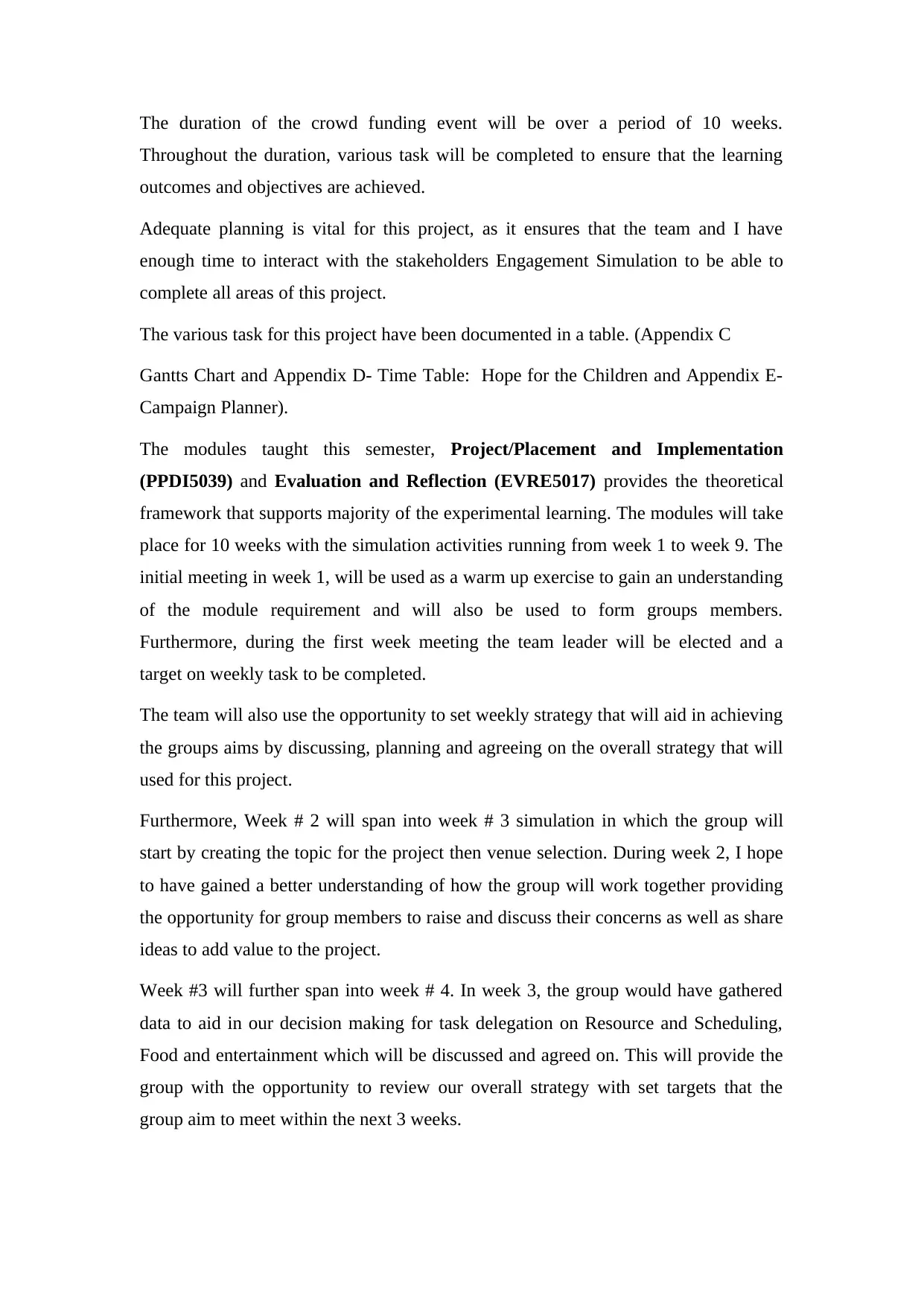
The duration of the crowd funding event will be over a period of 10 weeks.
Throughout the duration, various task will be completed to ensure that the learning
outcomes and objectives are achieved.
Adequate planning is vital for this project, as it ensures that the team and I have
enough time to interact with the stakeholders Engagement Simulation to be able to
complete all areas of this project.
The various task for this project have been documented in a table. (Appendix C
Gantts Chart and Appendix D- Time Table: Hope for the Children and Appendix E-
Campaign Planner).
The modules taught this semester, Project/Placement and Implementation
(PPDI5039) and Evaluation and Reflection (EVRE5017) provides the theoretical
framework that supports majority of the experimental learning. The modules will take
place for 10 weeks with the simulation activities running from week 1 to week 9. The
initial meeting in week 1, will be used as a warm up exercise to gain an understanding
of the module requirement and will also be used to form groups members.
Furthermore, during the first week meeting the team leader will be elected and a
target on weekly task to be completed.
The team will also use the opportunity to set weekly strategy that will aid in achieving
the groups aims by discussing, planning and agreeing on the overall strategy that will
used for this project.
Furthermore, Week # 2 will span into week # 3 simulation in which the group will
start by creating the topic for the project then venue selection. During week 2, I hope
to have gained a better understanding of how the group will work together providing
the opportunity for group members to raise and discuss their concerns as well as share
ideas to add value to the project.
Week #3 will further span into week # 4. In week 3, the group would have gathered
data to aid in our decision making for task delegation on Resource and Scheduling,
Food and entertainment which will be discussed and agreed on. This will provide the
group with the opportunity to review our overall strategy with set targets that the
group aim to meet within the next 3 weeks.
Throughout the duration, various task will be completed to ensure that the learning
outcomes and objectives are achieved.
Adequate planning is vital for this project, as it ensures that the team and I have
enough time to interact with the stakeholders Engagement Simulation to be able to
complete all areas of this project.
The various task for this project have been documented in a table. (Appendix C
Gantts Chart and Appendix D- Time Table: Hope for the Children and Appendix E-
Campaign Planner).
The modules taught this semester, Project/Placement and Implementation
(PPDI5039) and Evaluation and Reflection (EVRE5017) provides the theoretical
framework that supports majority of the experimental learning. The modules will take
place for 10 weeks with the simulation activities running from week 1 to week 9. The
initial meeting in week 1, will be used as a warm up exercise to gain an understanding
of the module requirement and will also be used to form groups members.
Furthermore, during the first week meeting the team leader will be elected and a
target on weekly task to be completed.
The team will also use the opportunity to set weekly strategy that will aid in achieving
the groups aims by discussing, planning and agreeing on the overall strategy that will
used for this project.
Furthermore, Week # 2 will span into week # 3 simulation in which the group will
start by creating the topic for the project then venue selection. During week 2, I hope
to have gained a better understanding of how the group will work together providing
the opportunity for group members to raise and discuss their concerns as well as share
ideas to add value to the project.
Week #3 will further span into week # 4. In week 3, the group would have gathered
data to aid in our decision making for task delegation on Resource and Scheduling,
Food and entertainment which will be discussed and agreed on. This will provide the
group with the opportunity to review our overall strategy with set targets that the
group aim to meet within the next 3 weeks.
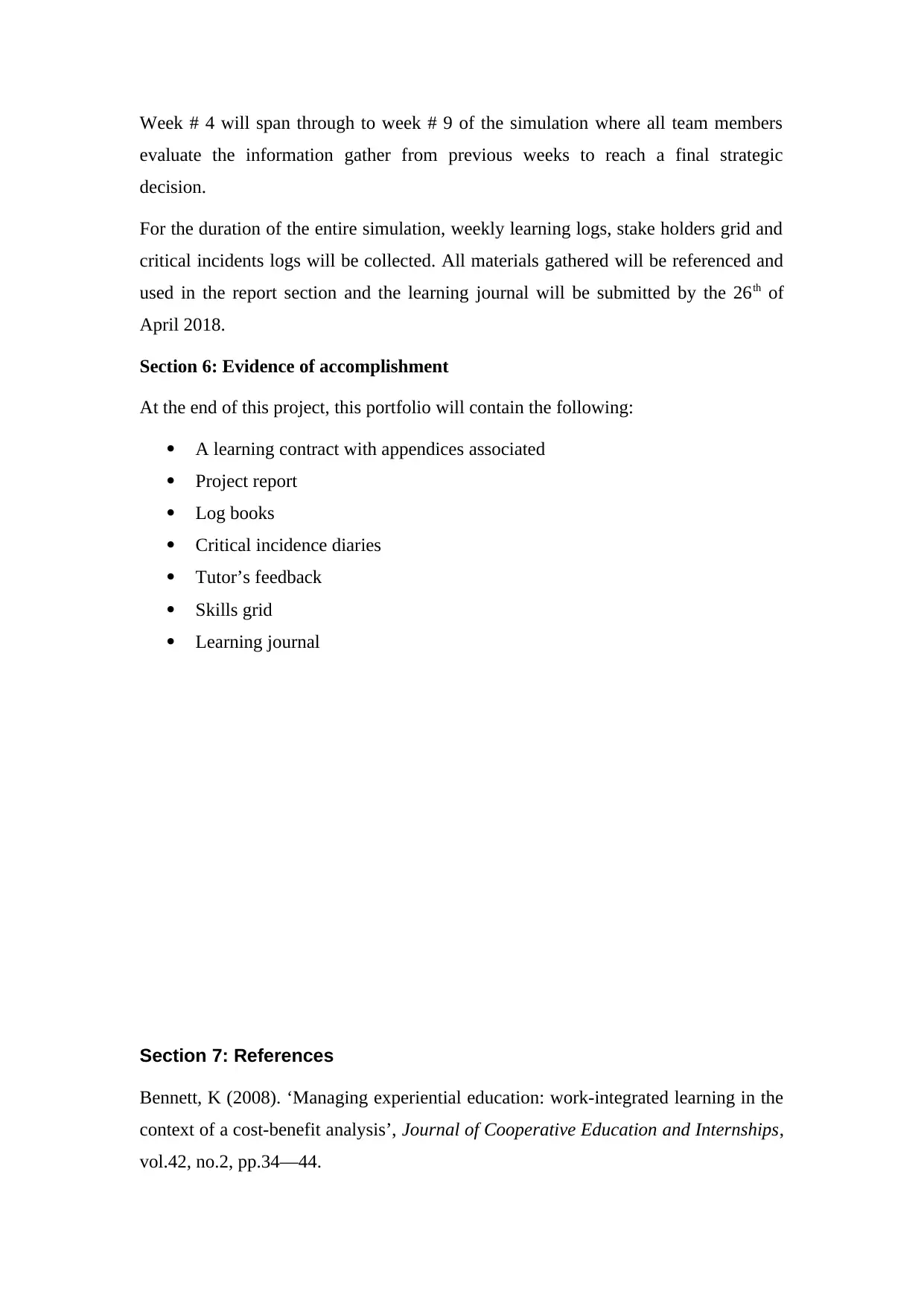
Week # 4 will span through to week # 9 of the simulation where all team members
evaluate the information gather from previous weeks to reach a final strategic
decision.
For the duration of the entire simulation, weekly learning logs, stake holders grid and
critical incidents logs will be collected. All materials gathered will be referenced and
used in the report section and the learning journal will be submitted by the 26th of
April 2018.
Section 6: Evidence of accomplishment
At the end of this project, this portfolio will contain the following:
A learning contract with appendices associated
Project report
Log books
Critical incidence diaries
Tutor’s feedback
Skills grid
Learning journal
Section 7: References
Bennett, K (2008). ‘Managing experiential education: work-integrated learning in the
context of a cost-benefit analysis’, Journal of Cooperative Education and Internships,
vol.42, no.2, pp.34—44.
evaluate the information gather from previous weeks to reach a final strategic
decision.
For the duration of the entire simulation, weekly learning logs, stake holders grid and
critical incidents logs will be collected. All materials gathered will be referenced and
used in the report section and the learning journal will be submitted by the 26th of
April 2018.
Section 6: Evidence of accomplishment
At the end of this project, this portfolio will contain the following:
A learning contract with appendices associated
Project report
Log books
Critical incidence diaries
Tutor’s feedback
Skills grid
Learning journal
Section 7: References
Bennett, K (2008). ‘Managing experiential education: work-integrated learning in the
context of a cost-benefit analysis’, Journal of Cooperative Education and Internships,
vol.42, no.2, pp.34—44.
⊘ This is a preview!⊘
Do you want full access?
Subscribe today to unlock all pages.

Trusted by 1+ million students worldwide
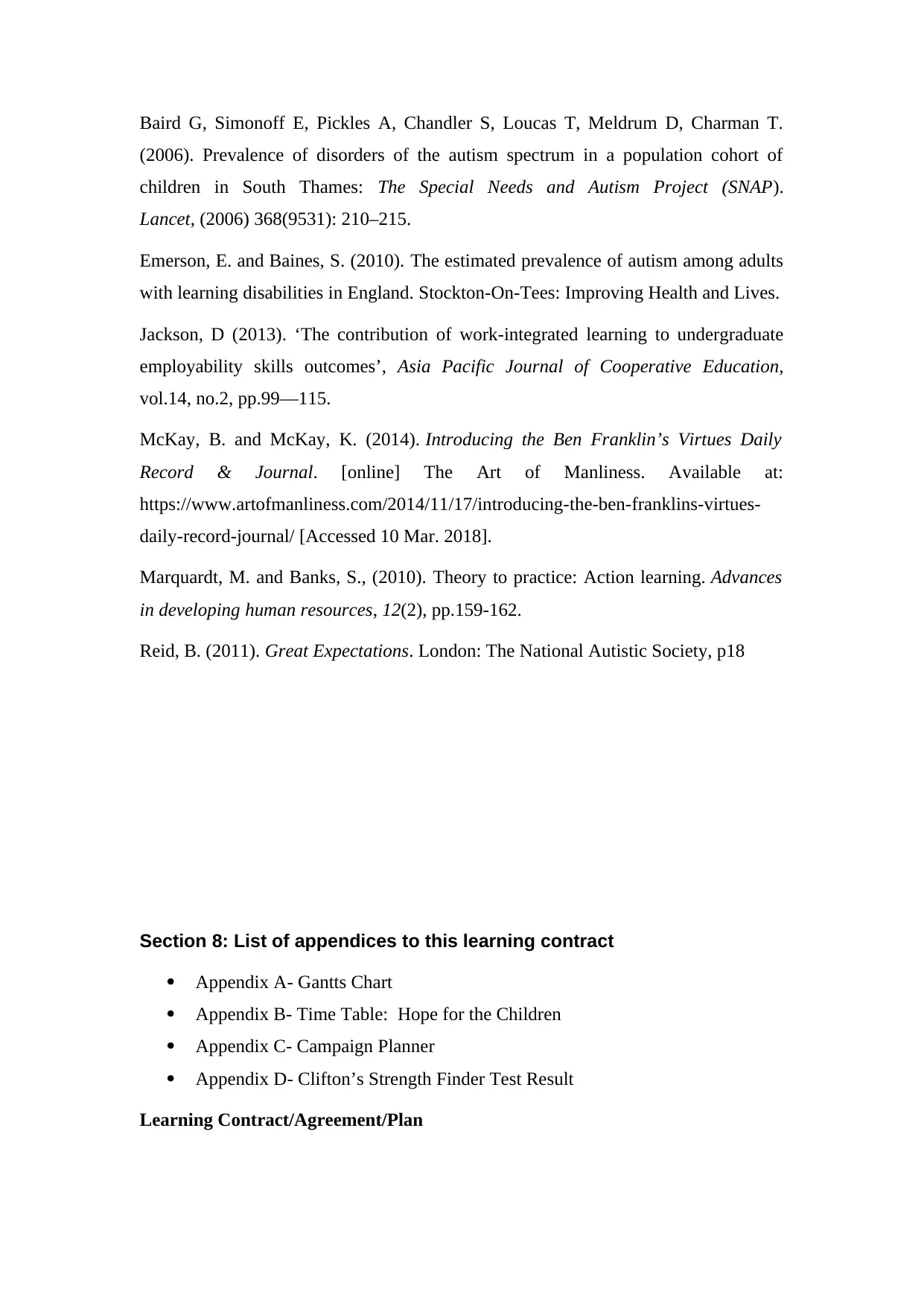
Baird G, Simonoff E, Pickles A, Chandler S, Loucas T, Meldrum D, Charman T.
(2006). Prevalence of disorders of the autism spectrum in a population cohort of
children in South Thames: The Special Needs and Autism Project (SNAP).
Lancet, (2006) 368(9531): 210–215.
Emerson, E. and Baines, S. (2010). The estimated prevalence of autism among adults
with learning disabilities in England. Stockton-On-Tees: Improving Health and Lives.
Jackson, D (2013). ‘The contribution of work-integrated learning to undergraduate
employability skills outcomes’, Asia Pacific Journal of Cooperative Education,
vol.14, no.2, pp.99—115.
McKay, B. and McKay, K. (2014). Introducing the Ben Franklin’s Virtues Daily
Record & Journal. [online] The Art of Manliness. Available at:
https://www.artofmanliness.com/2014/11/17/introducing-the-ben-franklins-virtues-
daily-record-journal/ [Accessed 10 Mar. 2018].
Marquardt, M. and Banks, S., (2010). Theory to practice: Action learning. Advances
in developing human resources, 12(2), pp.159-162.
Reid, B. (2011). Great Expectations. London: The National Autistic Society, p18
Section 8: List of appendices to this learning contract
Appendix A- Gantts Chart
Appendix B- Time Table: Hope for the Children
Appendix C- Campaign Planner
Appendix D- Clifton’s Strength Finder Test Result
Learning Contract/Agreement/Plan
(2006). Prevalence of disorders of the autism spectrum in a population cohort of
children in South Thames: The Special Needs and Autism Project (SNAP).
Lancet, (2006) 368(9531): 210–215.
Emerson, E. and Baines, S. (2010). The estimated prevalence of autism among adults
with learning disabilities in England. Stockton-On-Tees: Improving Health and Lives.
Jackson, D (2013). ‘The contribution of work-integrated learning to undergraduate
employability skills outcomes’, Asia Pacific Journal of Cooperative Education,
vol.14, no.2, pp.99—115.
McKay, B. and McKay, K. (2014). Introducing the Ben Franklin’s Virtues Daily
Record & Journal. [online] The Art of Manliness. Available at:
https://www.artofmanliness.com/2014/11/17/introducing-the-ben-franklins-virtues-
daily-record-journal/ [Accessed 10 Mar. 2018].
Marquardt, M. and Banks, S., (2010). Theory to practice: Action learning. Advances
in developing human resources, 12(2), pp.159-162.
Reid, B. (2011). Great Expectations. London: The National Autistic Society, p18
Section 8: List of appendices to this learning contract
Appendix A- Gantts Chart
Appendix B- Time Table: Hope for the Children
Appendix C- Campaign Planner
Appendix D- Clifton’s Strength Finder Test Result
Learning Contract/Agreement/Plan
Paraphrase This Document
Need a fresh take? Get an instant paraphrase of this document with our AI Paraphraser
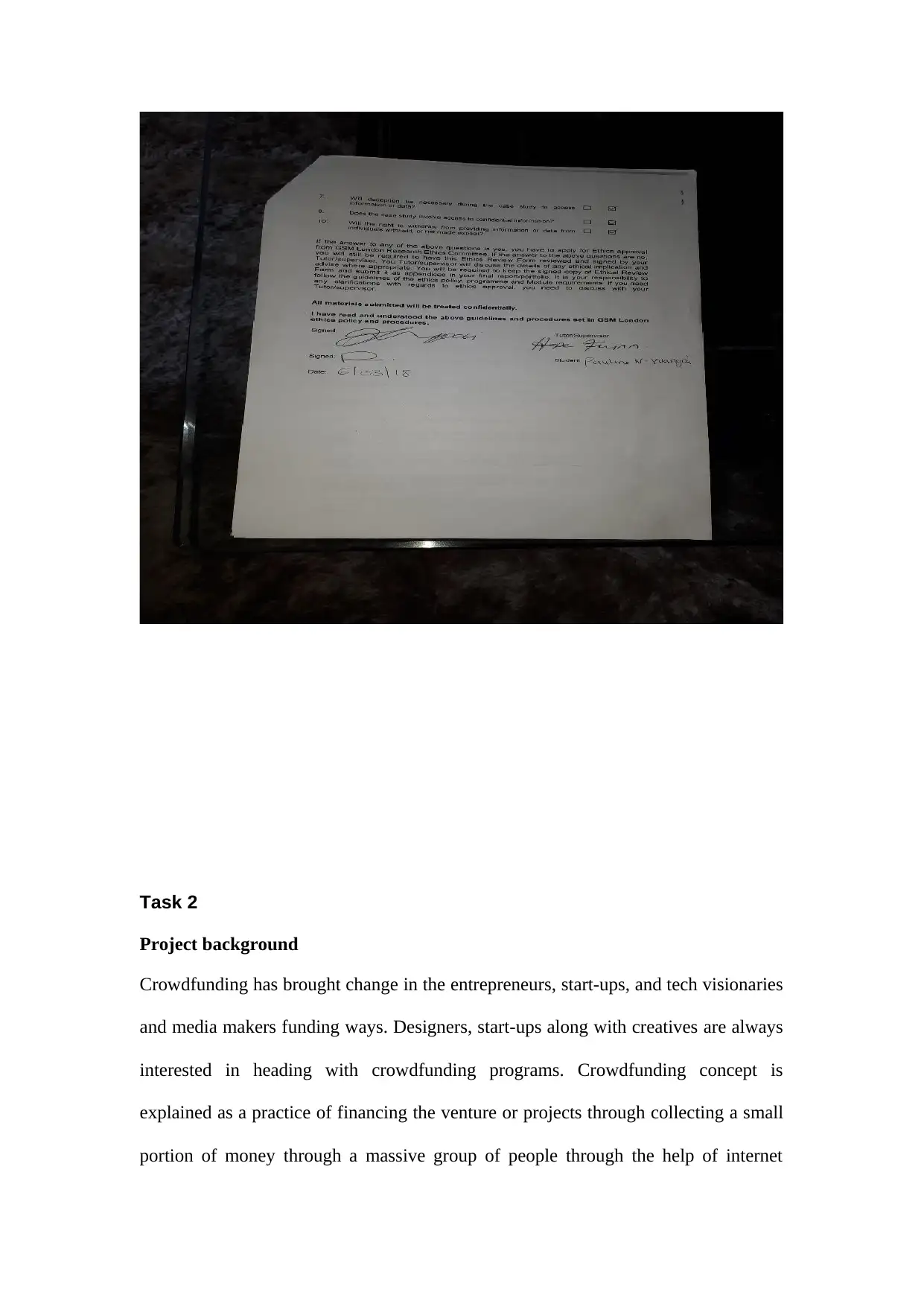
Task 2
Project background
Crowdfunding has brought change in the entrepreneurs, start-ups, and tech visionaries
and media makers funding ways. Designers, start-ups along with creatives are always
interested in heading with crowdfunding programs. Crowdfunding concept is
explained as a practice of financing the venture or projects through collecting a small
portion of money through a massive group of people through the help of internet
Project background
Crowdfunding has brought change in the entrepreneurs, start-ups, and tech visionaries
and media makers funding ways. Designers, start-ups along with creatives are always
interested in heading with crowdfunding programs. Crowdfunding concept is
explained as a practice of financing the venture or projects through collecting a small
portion of money through a massive group of people through the help of internet
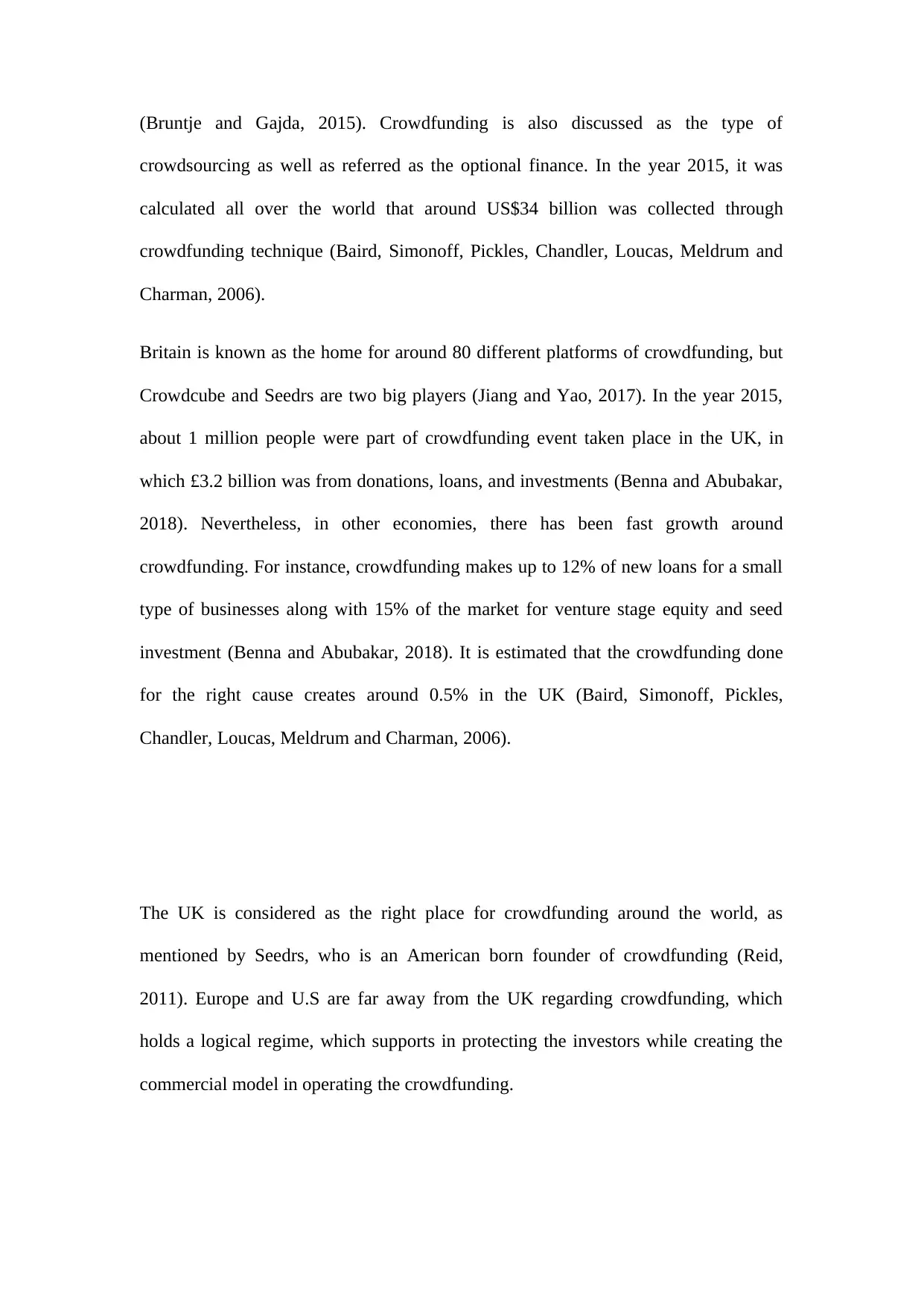
(Bruntje and Gajda, 2015). Crowdfunding is also discussed as the type of
crowdsourcing as well as referred as the optional finance. In the year 2015, it was
calculated all over the world that around US$34 billion was collected through
crowdfunding technique (Baird, Simonoff, Pickles, Chandler, Loucas, Meldrum and
Charman, 2006).
Britain is known as the home for around 80 different platforms of crowdfunding, but
Crowdcube and Seedrs are two big players (Jiang and Yao, 2017). In the year 2015,
about 1 million people were part of crowdfunding event taken place in the UK, in
which £3.2 billion was from donations, loans, and investments (Benna and Abubakar,
2018). Nevertheless, in other economies, there has been fast growth around
crowdfunding. For instance, crowdfunding makes up to 12% of new loans for a small
type of businesses along with 15% of the market for venture stage equity and seed
investment (Benna and Abubakar, 2018). It is estimated that the crowdfunding done
for the right cause creates around 0.5% in the UK (Baird, Simonoff, Pickles,
Chandler, Loucas, Meldrum and Charman, 2006).
The UK is considered as the right place for crowdfunding around the world, as
mentioned by Seedrs, who is an American born founder of crowdfunding (Reid,
2011). Europe and U.S are far away from the UK regarding crowdfunding, which
holds a logical regime, which supports in protecting the investors while creating the
commercial model in operating the crowdfunding.
crowdsourcing as well as referred as the optional finance. In the year 2015, it was
calculated all over the world that around US$34 billion was collected through
crowdfunding technique (Baird, Simonoff, Pickles, Chandler, Loucas, Meldrum and
Charman, 2006).
Britain is known as the home for around 80 different platforms of crowdfunding, but
Crowdcube and Seedrs are two big players (Jiang and Yao, 2017). In the year 2015,
about 1 million people were part of crowdfunding event taken place in the UK, in
which £3.2 billion was from donations, loans, and investments (Benna and Abubakar,
2018). Nevertheless, in other economies, there has been fast growth around
crowdfunding. For instance, crowdfunding makes up to 12% of new loans for a small
type of businesses along with 15% of the market for venture stage equity and seed
investment (Benna and Abubakar, 2018). It is estimated that the crowdfunding done
for the right cause creates around 0.5% in the UK (Baird, Simonoff, Pickles,
Chandler, Loucas, Meldrum and Charman, 2006).
The UK is considered as the right place for crowdfunding around the world, as
mentioned by Seedrs, who is an American born founder of crowdfunding (Reid,
2011). Europe and U.S are far away from the UK regarding crowdfunding, which
holds a logical regime, which supports in protecting the investors while creating the
commercial model in operating the crowdfunding.
⊘ This is a preview!⊘
Do you want full access?
Subscribe today to unlock all pages.

Trusted by 1+ million students worldwide
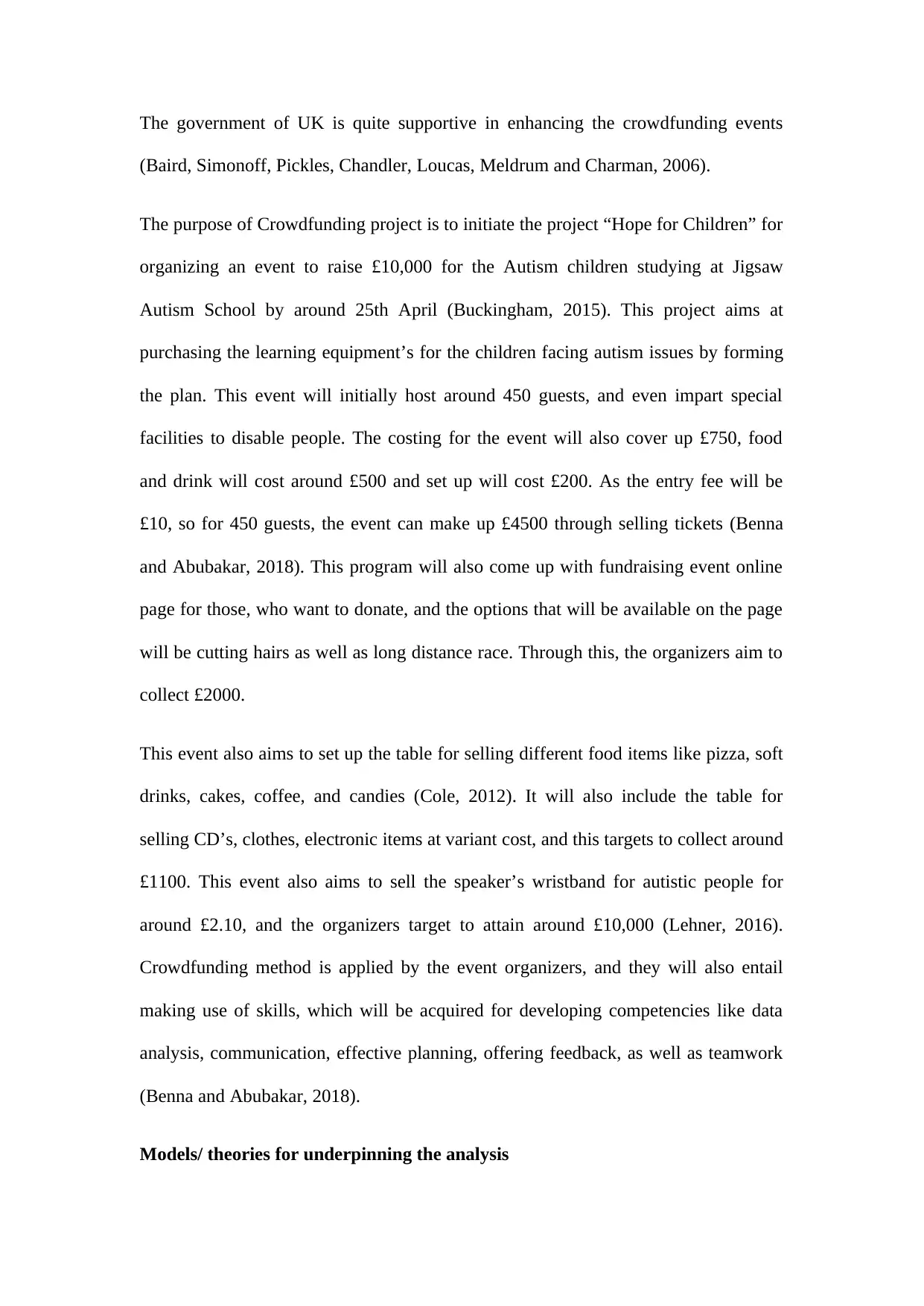
The government of UK is quite supportive in enhancing the crowdfunding events
(Baird, Simonoff, Pickles, Chandler, Loucas, Meldrum and Charman, 2006).
The purpose of Crowdfunding project is to initiate the project “Hope for Children” for
organizing an event to raise £10,000 for the Autism children studying at Jigsaw
Autism School by around 25th April (Buckingham, 2015). This project aims at
purchasing the learning equipment’s for the children facing autism issues by forming
the plan. This event will initially host around 450 guests, and even impart special
facilities to disable people. The costing for the event will also cover up £750, food
and drink will cost around £500 and set up will cost £200. As the entry fee will be
£10, so for 450 guests, the event can make up £4500 through selling tickets (Benna
and Abubakar, 2018). This program will also come up with fundraising event online
page for those, who want to donate, and the options that will be available on the page
will be cutting hairs as well as long distance race. Through this, the organizers aim to
collect £2000.
This event also aims to set up the table for selling different food items like pizza, soft
drinks, cakes, coffee, and candies (Cole, 2012). It will also include the table for
selling CD’s, clothes, electronic items at variant cost, and this targets to collect around
£1100. This event also aims to sell the speaker’s wristband for autistic people for
around £2.10, and the organizers target to attain around £10,000 (Lehner, 2016).
Crowdfunding method is applied by the event organizers, and they will also entail
making use of skills, which will be acquired for developing competencies like data
analysis, communication, effective planning, offering feedback, as well as teamwork
(Benna and Abubakar, 2018).
Models/ theories for underpinning the analysis
(Baird, Simonoff, Pickles, Chandler, Loucas, Meldrum and Charman, 2006).
The purpose of Crowdfunding project is to initiate the project “Hope for Children” for
organizing an event to raise £10,000 for the Autism children studying at Jigsaw
Autism School by around 25th April (Buckingham, 2015). This project aims at
purchasing the learning equipment’s for the children facing autism issues by forming
the plan. This event will initially host around 450 guests, and even impart special
facilities to disable people. The costing for the event will also cover up £750, food
and drink will cost around £500 and set up will cost £200. As the entry fee will be
£10, so for 450 guests, the event can make up £4500 through selling tickets (Benna
and Abubakar, 2018). This program will also come up with fundraising event online
page for those, who want to donate, and the options that will be available on the page
will be cutting hairs as well as long distance race. Through this, the organizers aim to
collect £2000.
This event also aims to set up the table for selling different food items like pizza, soft
drinks, cakes, coffee, and candies (Cole, 2012). It will also include the table for
selling CD’s, clothes, electronic items at variant cost, and this targets to collect around
£1100. This event also aims to sell the speaker’s wristband for autistic people for
around £2.10, and the organizers target to attain around £10,000 (Lehner, 2016).
Crowdfunding method is applied by the event organizers, and they will also entail
making use of skills, which will be acquired for developing competencies like data
analysis, communication, effective planning, offering feedback, as well as teamwork
(Benna and Abubakar, 2018).
Models/ theories for underpinning the analysis
Paraphrase This Document
Need a fresh take? Get an instant paraphrase of this document with our AI Paraphraser
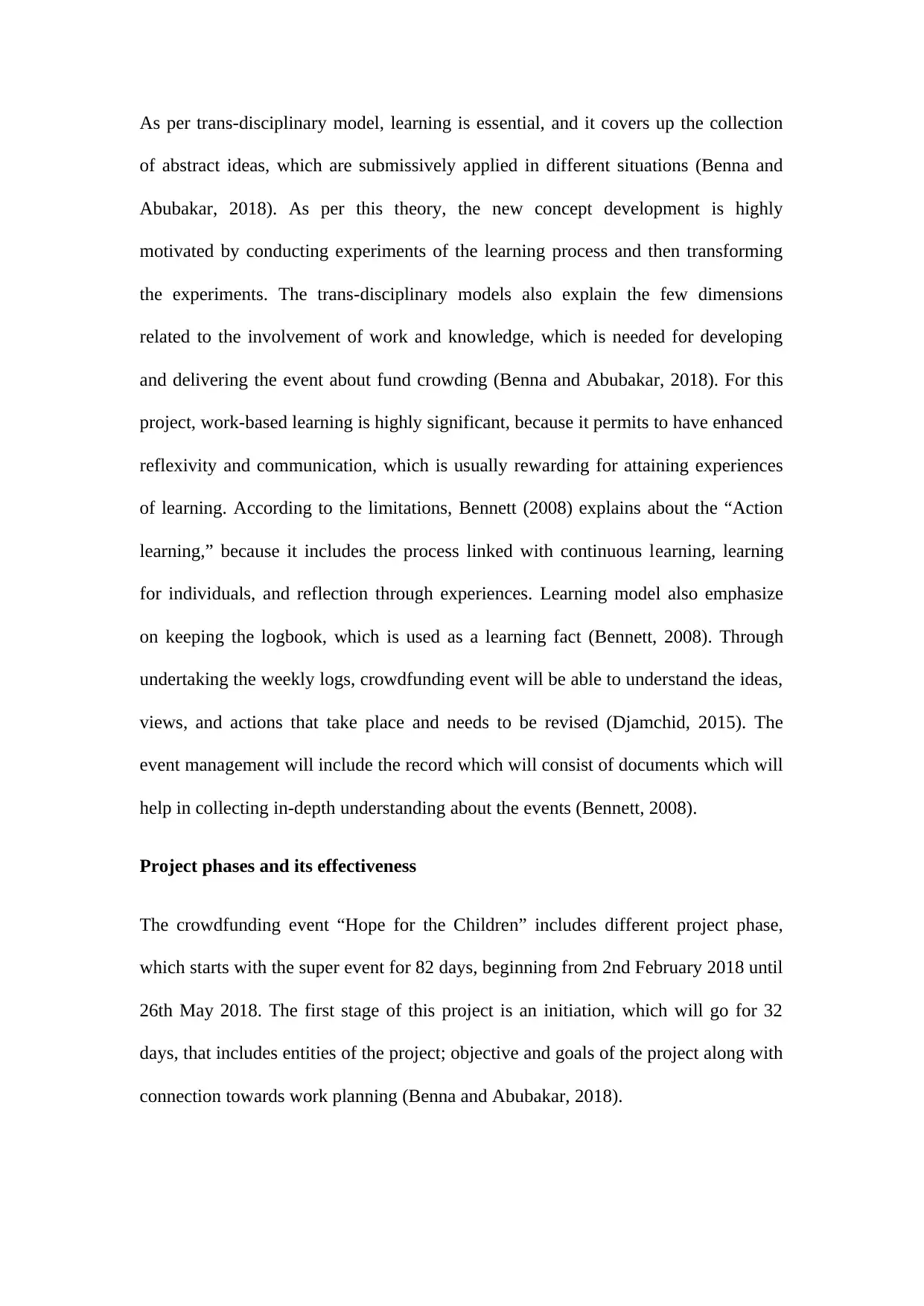
As per trans-disciplinary model, learning is essential, and it covers up the collection
of abstract ideas, which are submissively applied in different situations (Benna and
Abubakar, 2018). As per this theory, the new concept development is highly
motivated by conducting experiments of the learning process and then transforming
the experiments. The trans-disciplinary models also explain the few dimensions
related to the involvement of work and knowledge, which is needed for developing
and delivering the event about fund crowding (Benna and Abubakar, 2018). For this
project, work-based learning is highly significant, because it permits to have enhanced
reflexivity and communication, which is usually rewarding for attaining experiences
of learning. According to the limitations, Bennett (2008) explains about the “Action
learning,” because it includes the process linked with continuous learning, learning
for individuals, and reflection through experiences. Learning model also emphasize
on keeping the logbook, which is used as a learning fact (Bennett, 2008). Through
undertaking the weekly logs, crowdfunding event will be able to understand the ideas,
views, and actions that take place and needs to be revised (Djamchid, 2015). The
event management will include the record which will consist of documents which will
help in collecting in-depth understanding about the events (Bennett, 2008).
Project phases and its effectiveness
The crowdfunding event “Hope for the Children” includes different project phase,
which starts with the super event for 82 days, beginning from 2nd February 2018 until
26th May 2018. The first stage of this project is an initiation, which will go for 32
days, that includes entities of the project; objective and goals of the project along with
connection towards work planning (Benna and Abubakar, 2018).
of abstract ideas, which are submissively applied in different situations (Benna and
Abubakar, 2018). As per this theory, the new concept development is highly
motivated by conducting experiments of the learning process and then transforming
the experiments. The trans-disciplinary models also explain the few dimensions
related to the involvement of work and knowledge, which is needed for developing
and delivering the event about fund crowding (Benna and Abubakar, 2018). For this
project, work-based learning is highly significant, because it permits to have enhanced
reflexivity and communication, which is usually rewarding for attaining experiences
of learning. According to the limitations, Bennett (2008) explains about the “Action
learning,” because it includes the process linked with continuous learning, learning
for individuals, and reflection through experiences. Learning model also emphasize
on keeping the logbook, which is used as a learning fact (Bennett, 2008). Through
undertaking the weekly logs, crowdfunding event will be able to understand the ideas,
views, and actions that take place and needs to be revised (Djamchid, 2015). The
event management will include the record which will consist of documents which will
help in collecting in-depth understanding about the events (Bennett, 2008).
Project phases and its effectiveness
The crowdfunding event “Hope for the Children” includes different project phase,
which starts with the super event for 82 days, beginning from 2nd February 2018 until
26th May 2018. The first stage of this project is an initiation, which will go for 32
days, that includes entities of the project; objective and goals of the project along with
connection towards work planning (Benna and Abubakar, 2018).
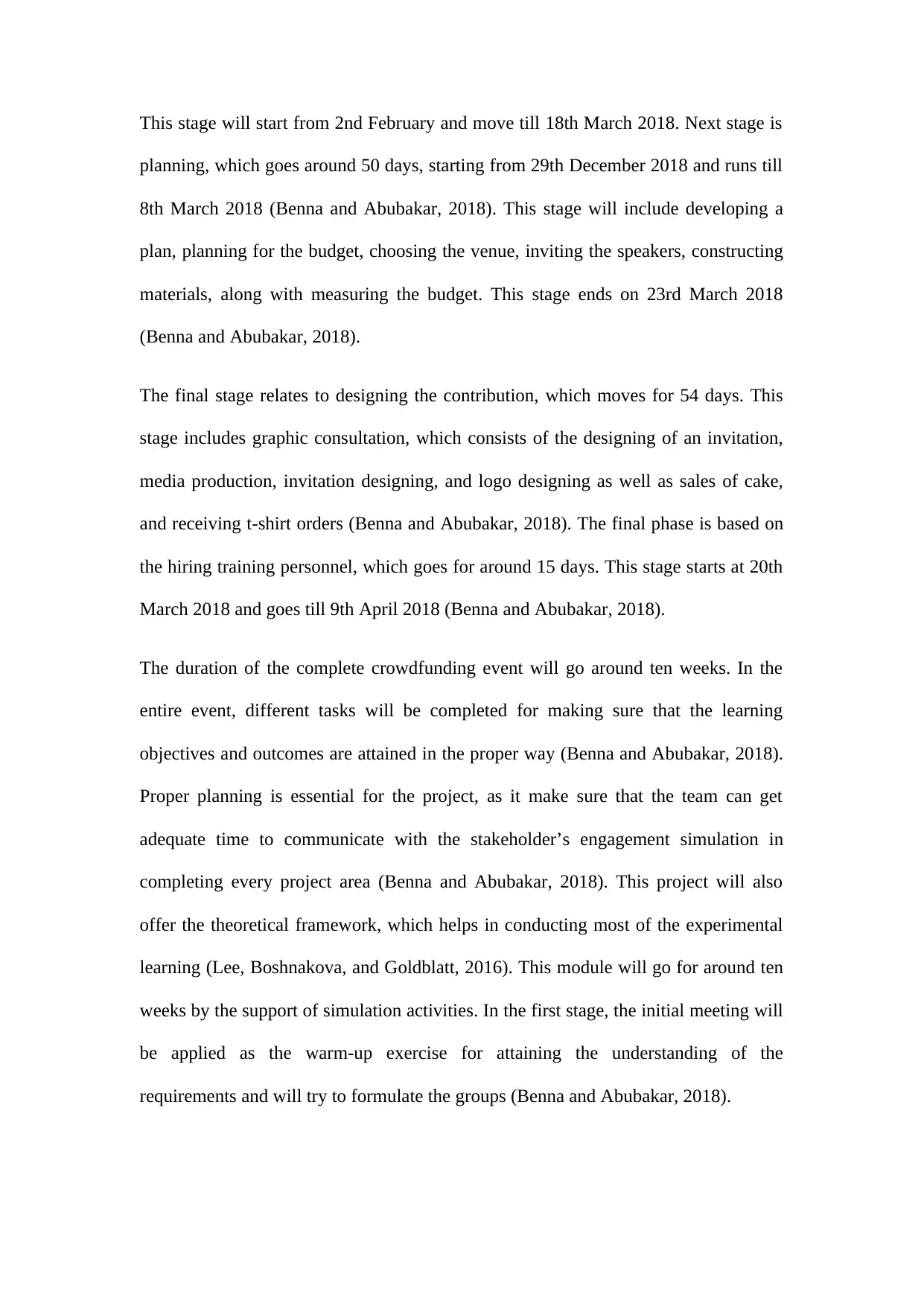
This stage will start from 2nd February and move till 18th March 2018. Next stage is
planning, which goes around 50 days, starting from 29th December 2018 and runs till
8th March 2018 (Benna and Abubakar, 2018). This stage will include developing a
plan, planning for the budget, choosing the venue, inviting the speakers, constructing
materials, along with measuring the budget. This stage ends on 23rd March 2018
(Benna and Abubakar, 2018).
The final stage relates to designing the contribution, which moves for 54 days. This
stage includes graphic consultation, which consists of the designing of an invitation,
media production, invitation designing, and logo designing as well as sales of cake,
and receiving t-shirt orders (Benna and Abubakar, 2018). The final phase is based on
the hiring training personnel, which goes for around 15 days. This stage starts at 20th
March 2018 and goes till 9th April 2018 (Benna and Abubakar, 2018).
The duration of the complete crowdfunding event will go around ten weeks. In the
entire event, different tasks will be completed for making sure that the learning
objectives and outcomes are attained in the proper way (Benna and Abubakar, 2018).
Proper planning is essential for the project, as it make sure that the team can get
adequate time to communicate with the stakeholder’s engagement simulation in
completing every project area (Benna and Abubakar, 2018). This project will also
offer the theoretical framework, which helps in conducting most of the experimental
learning (Lee, Boshnakova, and Goldblatt, 2016). This module will go for around ten
weeks by the support of simulation activities. In the first stage, the initial meeting will
be applied as the warm-up exercise for attaining the understanding of the
requirements and will try to formulate the groups (Benna and Abubakar, 2018).
planning, which goes around 50 days, starting from 29th December 2018 and runs till
8th March 2018 (Benna and Abubakar, 2018). This stage will include developing a
plan, planning for the budget, choosing the venue, inviting the speakers, constructing
materials, along with measuring the budget. This stage ends on 23rd March 2018
(Benna and Abubakar, 2018).
The final stage relates to designing the contribution, which moves for 54 days. This
stage includes graphic consultation, which consists of the designing of an invitation,
media production, invitation designing, and logo designing as well as sales of cake,
and receiving t-shirt orders (Benna and Abubakar, 2018). The final phase is based on
the hiring training personnel, which goes for around 15 days. This stage starts at 20th
March 2018 and goes till 9th April 2018 (Benna and Abubakar, 2018).
The duration of the complete crowdfunding event will go around ten weeks. In the
entire event, different tasks will be completed for making sure that the learning
objectives and outcomes are attained in the proper way (Benna and Abubakar, 2018).
Proper planning is essential for the project, as it make sure that the team can get
adequate time to communicate with the stakeholder’s engagement simulation in
completing every project area (Benna and Abubakar, 2018). This project will also
offer the theoretical framework, which helps in conducting most of the experimental
learning (Lee, Boshnakova, and Goldblatt, 2016). This module will go for around ten
weeks by the support of simulation activities. In the first stage, the initial meeting will
be applied as the warm-up exercise for attaining the understanding of the
requirements and will try to formulate the groups (Benna and Abubakar, 2018).
⊘ This is a preview!⊘
Do you want full access?
Subscribe today to unlock all pages.

Trusted by 1+ million students worldwide
1 out of 40
Your All-in-One AI-Powered Toolkit for Academic Success.
+13062052269
info@desklib.com
Available 24*7 on WhatsApp / Email
![[object Object]](/_next/static/media/star-bottom.7253800d.svg)
Unlock your academic potential
Copyright © 2020–2025 A2Z Services. All Rights Reserved. Developed and managed by ZUCOL.
